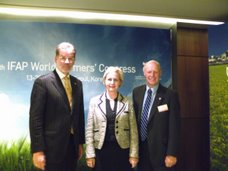Mr. Simon Asatryan is a farmer in Armenia. After the collapse of the former Soviet-Union in 1991, Mr. Simon and his family acquired one hectare of agricultural land in his village as part of the agrarian reform program. He was also able to buy an additional one hectare of agricultural land in 2002. At that time, Mr. Simon Asatryan was growing grapes and apricots. The famous Armenian apricots were mainly for export to Russia, whereas grapes were mainly sold in the local market.
How is your situation now? What has changed?
During the last six years, Mr. Simon Asatryan has been able to acquire 4 additional hectares of land. Currently, he is also renting 2 hectares of land, making the total area of land under cultivation 8 hectares, mainly with grapes and apricots. According to Mr. Simon Asatryan, there is a continuous need for expanding the farm land in order to survive as a farmer. But, in recent years land has become scarce in his village. A big agri-business firm has recently acquired a large piece of waste land to establish vineyards with French grapes. This could be a good opportunity for the farmers in this village as the agri-business firm will probably also establish a winery and additional infrastructure, giving alternative market outlets for the farmers. The recent conflict between Russia and Georgia has been worrisome in terms of export of apricots to Russia as trucks could not pass disputed territory. New routes through Turkey, Bulgaria and Ukraine were explored to reach the Moscow market. Fortunately, although using this longer alternative route, exporting was still profitable.
Which changes were most important/far reaching? Why?
How/why did these changes come about? (describe process and what caused these changes?)
Mr. Simon Asatryan has been a founding member of Aygegorts Agricultural Association in 2002. Since then, he has been actively engaged. He considers being member of this cooperative as crucial for his farm as alone he would not be able to solve many problems. For example, Mr. Simon Asatryan acquires agricultural inputs like fertilizer and fuel through his cooperative at a lower-than-market prices, often the advantage is more than 20%. At the same time, the cooperative guarantees good quality inputs at the right time! The cooperative also gives him access to training and consultancy services from FAA (Federation of Agricultural Associations), the national level federation of 17 agricultural association. Finally, the Federation is facilitating the exports to foreign markets, ensuring that he can sell his apricots at a good price!
Tuesday, September 11, 2007
Subscribe to:
Post Comments (Atom)
Check these interesting contributions from other sites & blogs
- On Farmers Organization in Egypt
- Law on farmers Organizations in China
- Interview with FAO officials on Farmers Organizations
- Farmers use mobile phones
- comment of Kees Blokland on anti-CAP campaigning
- Poverty & growth blog of the World Bank
- Gapminder statistics visualized
- Guide for implementing ICT projects - iCommons december 2006
- Africa: tools of liberalisation - Patricia Daniel, University of Wolverhampton, England
- Business and the rural poor - Harvard Business School
- Profiling Asian Farmers Association members - Jan 4th, 2007
- Fiji Times report on AgriCord grants to Sugar Farmers - January 04, 2007
- Increasing Impact - marrying micro-credit and micro-insurance - The disconfort Zone, january 4th, 2007
- Programs that Fight Poverty - Institute for Advanced Technologies in Global Resilience - November 17, 2006
- University of Chicago Press Journals reports on GMOs - January 25, 2007
- Biotech crops to help reduce poverty - Kauser A Malik, in the Daily Times (Pakistan) January 25, 2007
- Why does China grow so fast - Michael Spence The Wall Street Journal 23 january 2007






No comments:
Post a Comment